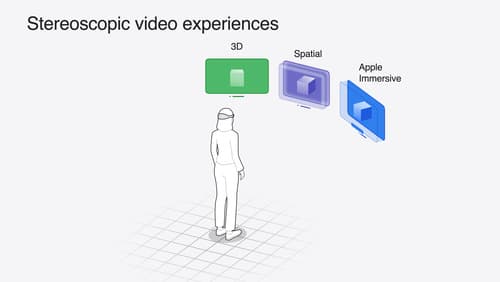what is spatial audio
Asked on 2024-08-01
1 search
Spatial audio is a technology that enhances the auditory experience by simulating how sound behaves in the real world. It allows audio to be perceived as coming from specific directions and distances, creating a more immersive and realistic sound environment. Here are some key aspects of spatial audio as discussed in various WWDC sessions:
-
Six Degrees of Freedom: Spatial audio updates its level and tonality as either the listener or the audio source moves or rotates, providing a dynamic auditory experience (Enhance your spatial computing app with RealityKit audio).
-
Distance Attenuation: The volume of the audio decreases naturally as the source moves away from the listener, mimicking real-world sound behavior (Enhance your spatial computing app with RealityKit audio).
-
Reverb and Environment Simulation: Spatial audio can simulate reverb based on the listener's real surroundings, adding another layer of realism (Enhance your spatial computing app with RealityKit audio).
-
Directional Characteristics: You can set the directional characteristics of the audio source, such as making the sound quieter and darker at the rear than at the front (Enhance your spatial computing app with RealityKit audio).
-
Immersive Experiences: Spatial audio is used to create immersive experiences in applications, such as bringing a world to life with background ambience and directional cues (Design interactive experiences for visionOS).
-
Customizable Distance Attenuation: Developers can customize how quickly sound attenuates with distance, allowing for creative control over the auditory experience (Enhance your spatial computing app with RealityKit audio).
For more detailed information, you can refer to the following sessions:

Design interactive experiences for visionOS
Learn how you can design a compelling interactive narrative experience for Apple Vision Pro from the designers of Encounter Dinosaurs. Discover how these types of experiences differ from existing apps, media, and games, and explore how to design narratives that bring audiences into new worlds. Find out how you can create stories that adapt to any space and size, provide multiple levels of interaction to make them accessible to all, and use animation, spatial audio, and custom gestures to further immerse people in your experience.

Build compelling spatial photo and video experiences
Learn how to adopt spatial photos and videos in your apps. Explore the different types of stereoscopic media and find out how to capture spatial videos in your iOS app on iPhone 15 Pro. Discover the various ways to detect and present spatial media, including the new QuickLook Preview Application API in visionOS. And take a deep dive into the metadata and stereo concepts that make a photo or video spatial.

Enhance your spatial computing app with RealityKit audio
Elevate your spatial computing experience using RealityKit audio. Discover how spatial audio can make your 3D immersive experiences come to life. From ambient audio, reverb, to real-time procedural audio that can add character to your 3D content, learn how RealityKit audio APIs can help make your app more engaging.
